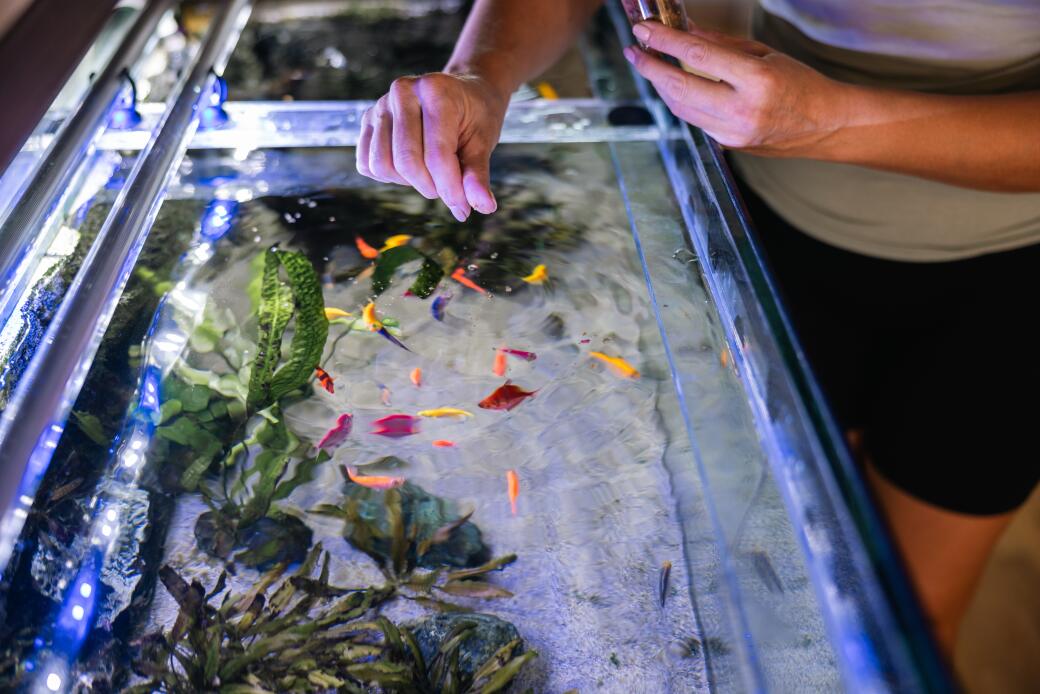Aquascaping with Changing Hardness, pH, or Lighting Conditions
When it comes to effectively managing the water hardness, pH and lighting conditions of your planted aquariums, it’s easy to feel overwhelmed. Just remember that in general, it’s not likely that a single factor is responsible if you’re dealing with a tricky situation. Instead, it’s often a delicately choreographed dance between nutrient levels, substrate, and the plants you choose to grow.
Water Hardness, pH, and Planted Aquarium Health

The pH scale runs from 0 to 14 (7 is neutral) and it measures the acidic (0-6.9) or basic (7.1-14) nature of a solution–in this case, your aquarium water. Each whole number change represents a logarithmic, tenfold change. The numbers indicate the amount of hydrogen ion concentration in the water. When dealing with a freshwater aquarium, a pH range that is slightly acidic to slightly alkaline (6.0 and 7.5) is ideal for most plant health and growth.
In the natural world, pH swings happen day in and out, thanks to the changes in carbon dioxide (CO2) concentrations as a result of the decomposition and photosynthesis cycle. In your plant aquariums, pH levels can affect the availability of certain nutrients to your plants, ultimately affecting growth and plant health. pH levels can also interact with General Hardness (GH) levels and Carbonate Hardness (KH) that measure dissolved calcium and magnesium or carbonates and bicarbonates respectively. Standard “hard” water is often a high GH level as well, meaning that it contains higher levels of dissolved minerals.
Stable pH is absolutely necessary for an ideal balance that helps, not hinders, plant growth. Beneficial bacteria that help to regulate biological life and processes also depend on proper pH levels to function well. If you have fish or other animals in your planted aquarium, pH is important for their health and wellbeing too.
If you see plant health decline and suspect a pH issue, you can test water regularly to know the levels you are working with. You can also use a substrate like AquaBed that is balanced and will not impact your aquarium’s pH levels. Natural buffers and additives can help you to release acidic or basic elements into the water as needed, based on test results. These can include:
- Acidic: Peat Moss, Driftwood, Catappa (Indian Almond) Leaves
- Basic: Crushed Coral, Aragonite Sand, or Limestone
And it’s worth considering your water source. Most tap water is safe to use, and if you match your aquascaping plants to your water source, all the better! There are many common and beginner friendly aquascaping plants that can thrive in varying levels of pH and light, and we’d recommend starting out with these low-maintenance, non-fussy options. It’s also going to be easier to choose species that already are known to thrive in your natural parameters than to constantly worry over pH, light and nutrient levels.
That said, if you are having ongoing pH problems, then it may be worth considering using reverse osmosis water. Alternatively, if you are able to safely collect and store clean rainwater, this is a naturally soft water source that is well-balanced and ideal for aquascaping use. For a quick lowering of pH, carbon dioxide (CO₂) is very effective and will also help to spur photosynthesis. Regular but small-scale water changes can help tremendously to buffer or regulate levels. Instead of a full emptying and refilling, opt for changing 10–20% of the water weekly to help keep parameters steady and predictable.
Managing Lighting & Its Effect on Aquascaping
Lighting is key to plant health and growth. Plants are sometimes called “light eaters” and with good reason. It is only with light that plants can convert the minerals and nutrients they uptake into “food” to fuel their growth.
Too little light can lead to lower rates of photosynthesis and may allow for more sustained plant growth, but result in limp, stretched foliage. It can even lead to elevated nutrient levels and algae growth, since the plants are not using the nutrients available to them due to the low light levels. On the other hand, light levels that are too high can lead to rapid CO₂ use and thus a rapid drop in pH. Depending on the plants in your aquarium, this could impact their health negatively. As is always true, a balance is best. Even, moderate light levels allow for proper CO₂ cycling and nutrient uptake and usage. It is possible to control pH swings so that they are within a smaller range and so less disrupting to plant health and growth.
AquaBed Makes Aquascaping Easy
Regardless of what key parameters you’re chasing when managing your planted aquariums, choosing AquaBed as your substrate will always help to mitigate common plant stressors. By providing all of the nutrients required for healthy plant growth in a compact, mess-free package, AquaBed simplifies the process. And because the substrate remains contained and eventually solidifies over time, it will never leach into your water and influence lighting needs. Materials used to craft AquaBed are vetted for pH balance, so you can rest assured that your aquarium plant growth will be healthy and sustained, affording you years of enjoyment and easy maintenance. Our substrate is also safe for use with all sorts of aquatic life, enabling you to have confidence as you grow in your aquascaping endeavors. It truly is the best foundation to build on!
Check out the difference that AquaBed makes and get your own to start aquascaping today. Feel free to contact us with any questions, and check out what our customers are saying!

